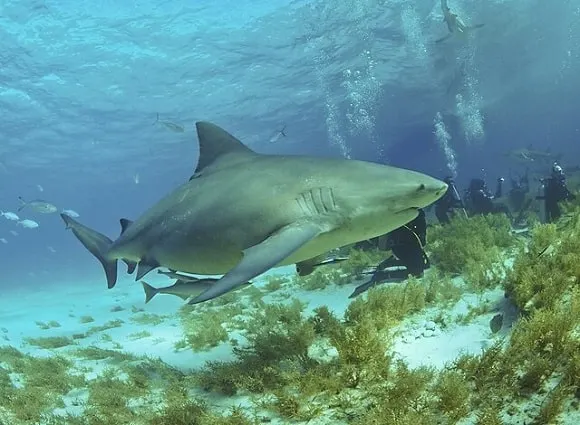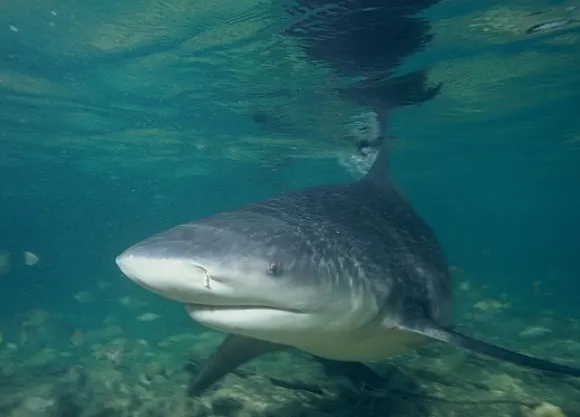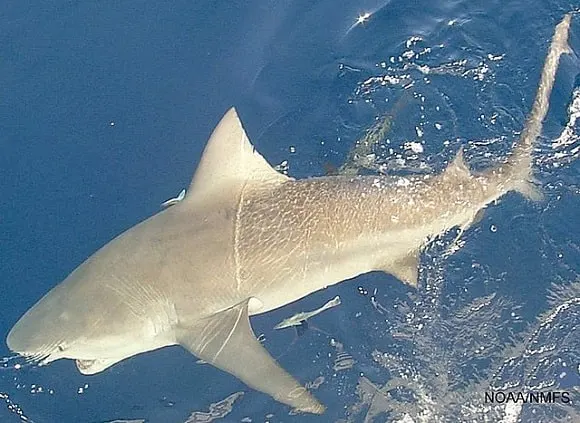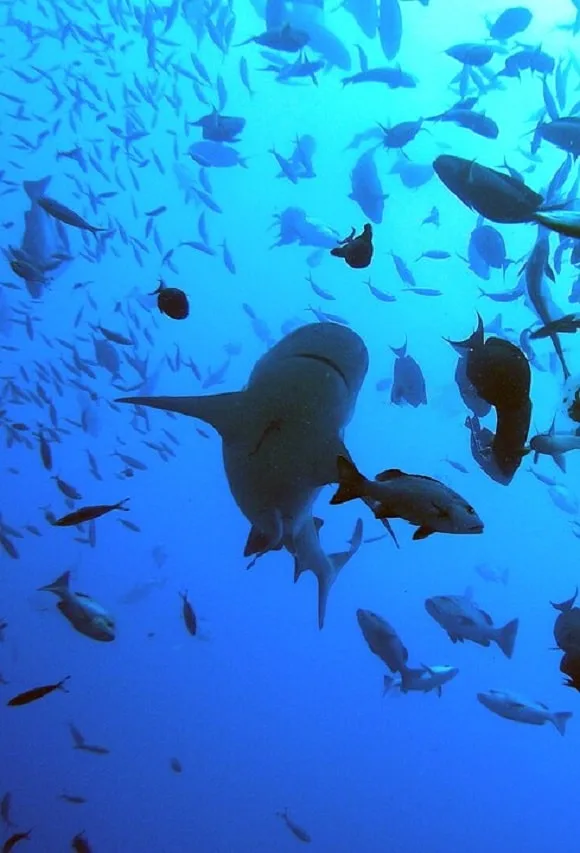Bull sharks are a fascinating species in the vast world of sharks.
With an aggressive nature that has sparked intrigue among researchers and shark anglers alike, they have made quite a name for themselves, not least due to their amazing size. But exactly how big do bull sharks actually get?
While the average size of bull sharks is between 5 and 9 feet and 200 to 550 lbs, bull sharks can reach a maximum size of 11 to 13 feet and 700 to 1,000 lbs. The world’s biggest sharks can be found in the Florida Keys, the Gulf of Mexico, the Indian Ocean, and Australia.
Continue reading this article and learn more about the average, maximum, and world record size of bull sharks.
What is the Maximum Size of Bull Sharks?
The maximum size of a bull shark (Carcharhinus leucas) depends on whether we’re talking males or females! Female bull sharks typically grow larger than their male counterparts. This is a phenomenon known as sexual dimorphism, which is common among sharks and many other fish species.
Females can reach a maximum length of about 11 feet. Male bull sharks, on the other hand, usually grow up to approximately 7 feet.
There is, however, one report of a gigantic female bull shark that measured exactly 13 feet. A research team tagging sharks in the Florida Keys was lucky enough to come across this enormous specimen.
As far as I know, this is the largest ever recorded bull shark on Earth!
It’s also important to talk about weight when considering the size of these oceanic predators.
The maximum weight of female bull sharks is somewhere between 500 and 700 lbs, although some specimens of 800 to 1,000 lbs have been reported.
However, those sharks were, for the most part, pregnant females.
This substantial mass, coupled with their muscular, robust build, contributes to their reputation as one of the most formidable predators in both freshwater and saltwater environments.
The larger females are thought to gain an evolutionary advantage by being able to produce more and larger offspring, an attribute that directly contributes to the survivability of the species.
The massive size of the bull shark not only aids in its reproductive success but also its predatory nature.
One must remember that they are opportunistic feeders with a wide-ranging diet. This diet consists primarily of bony fish, smaller sharks, and other bull sharks.
However, they are also known to feed on turtles, birds, dolphins, and terrestrial mammals when available.
Their size is critical in their ability to take down such a diverse range of prey.
What is the Average Size of Bull Sharks?

Having explored the maximum sizes that bull sharks can attain, it’s equally important to cover their average size.
This provides a more realistic image of the average adult bull shark one might encounter in the wild or have on the end of a fishing line.
In terms of length, the average size of an adult bull shark is around 5 to 6 feet for males and approximately 7 to 9 feet for females.
These are the typical lengths a healthy, mature bull shark can reach in the wild.
Let’s take a look at the average weight of adult bull sharks.
A fully-grown female bull shark usually weighs between 250 to 550 lbs. On the contrary, male bull sharks generally average a weight of about 200 to 300lb.
While bull sharks can grow to impressive sizes, understanding their average size provides a more accurate representation of the species, as most individuals will be in that average size range.
These insights are valuable to both passionate anglers and shark enthusiasts, providing a well-rounded perspective on these fascinating creatures.
What is the Biggest Bull Shark Ever Caught?
As fascinating as the bull shark’s average and maximum size may be, nothing compares to the thrill of the record-breaking catches that, from time to time, surface in the fishing world.
The International Game Fish Association (IGFA) maintains a comprehensive database of these records, providing a definitive source of information for some of the most notable catches in history.
The biggest bull shark ever officially recorded was caught by angler Ronald de Jager off the coast of Kenya, in the Indian Ocean, near Malindi, back in 2001.
This colossal specimen tipped the scales at an impressive 697lb 12oz, an all-tackle world record that still stands today.
The shark’s exact length was not officially recorded, but considering the usual body proportions of bull sharks, it can be assumed that this specimen was likely around 11 feet. In other words, a true giant!
It’s important to remember that such record-breaking catches are the exception rather than the rule, with most bull sharks encountered by anglers or scientists being significantly smaller.
Furthermore, fishing for bull sharks, like any species, should always be conducted responsibly, adhering to local regulations and conservation guidelines to ensure these remarkable predators’ continued survival and health.
How Fast Do Bull Sharks Grow?

Bull sharks grow throughout their entire life, albeit slower as they reach maturity.
As with many aspects of shark biology, precise details can vary and are often challenging to determine, yet scientists have made considerable strides in understanding the growth patterns of these sharks.
Juvenile bull sharks grow relatively quickly during the first two years of their life, with estimated growth rates of around 6-7 inches annually.
This rapid growth allows them to reach a size where they have fewer potential predators and can access a broader range of prey items.
As bull sharks reach maturity, their growth rate slows considerably.
Adult bull sharks typically grow approximately 1-1.5 inches per year, which is relatively slow compared to other shark species.
REMEMBER: It’s important to note that several factors, including diet, habitat quality, and overall health, can influence these rates.
Maturity in bull sharks typically occurs when males reach a length of about 5 to 6 feet and females a length of approximately 7 feet.
They then maintain their relatively slow annual growth rate of 1 to 1.50 inches throughout the rest of their lives.
Where are the Biggest Bull Sharks in the World Found?

Due to their unique ability to tolerate both saltwater and freshwater, bull sharks have a vast global distribution.
They can be found in warm coastal areas (saltwater), and rivers and estuaries (freshwater).
The locations known for having bigger than average bull shark specimens are spread throughout this range, often areas rich in prey and ideal for the growth and survival of these predators.
Indian Ocean
One of the most notable locations is off the coast of Kenya in the Indian Ocean. This area is known for its warm waters and abundant food supply, ideal conditions for bull sharks to reach their maximum size.
As mentioned above, this is where the current all-tackle world record bull shark has been caught.
Florida, USA
Florida is another hotspot for large bull sharks. They’re frequently found in the state’s coastal waters and even venture inland via rivers and canals.
Florida’s warm climate and the abundant prey in its waters are conducive to the bull sharks’ growth. The waters around the Florida Keys, in particular, are a renowned habitat for giant bull sharks.
Gulf of Mexico
The Gulf of Mexico, especially the coastal areas off Texas and Louisiana, are also known for their populations of large-grown bull sharks.
The nutrient-rich waters of this area provide an excellent food supply, contributing to the growth of larger specimens.
Australia
Australia, known for its shark abundance, is also home to large bull sharks.
They are regularly sighted in both the eastern and western coastal waters, including Sydney Harbour, the Brisbane River, and along the Gold Coast.
Australia’s coastal regions are teeming with prey, making it an ideal habitat for bull sharks to grow and thrive.
Zambezi River, Africa

The Zambezi River in Africa, particularly the area below the Victoria Falls, is another place known for huge bull sharks, locally referred to as “Zambezi sharks” or “Zambi.”
These freshwater habitats are unique as they support the growth of bull sharks pretty far from the ocean. I find that extremely fascinating, by the way!
So while bull sharks are widespread, the locations known for hosting the larger specimens share some common traits: warm waters and plentiful prey.
These conditions are vital to the growth of bull sharks, enabling them to reach their impressive size.
Are Bull Sharks Bigger than Tiger Sharks?
Both bull sharks and tiger sharks are among the largest shark species, and they are recognized for their powerful builds and formidable presence in their respective habitats.
However, when we compare the sizes of these two species directly, tiger sharks generally come out on top.
Tiger sharks are among the ocean’s largest predators.
Females, which are usually larger than males, can grow up to 18 feet in length, and there are even unverified reports of tiger sharks of more than 20 feet.
Regarding weight, a female adult tiger shark can weigh between 1,500 and 2,000 lbs, vastly outweighing the maximum weight of bull sharks.
RELATED ARTICLE: How Big Is the Average Tiger Shark?
Are Bull Sharks Bigger than Hammerhead Sharks?
The hammerhead family, or Sphyrnidae, includes several species, each with its own unique size range.
When comparing bull sharks with hammerheads, it’s essential to specify which type of hammerhead we’re talking about, as their sizes can significantly differ.
For this comparison, we’ll use the most well-known and largest species, the great hammerhead (Sphyrna mokarran).
The great hammerhead sharp can reach a length of about 16 to 18 feet, making them one of the longest predatory shark species.
When it comes to weight, hammerheads have a maximum weight of about 1,300 lbs.
So hammerheads are both longer and heavier than bull sharks, even though they are typically a lot slimmer.
RELATED ARTICLE: What Is the Biggest Hammerhead Shark Ever Caught?
Are Bull Sharks Bigger than Great White Sharks?
The most apparent distinction in size is between bull sharks and great whites. Although to be fair, no other shark species measures up to Jaws, so it’s a somewhat unfair game!
Great white sharks are renowned not only for their reputation in popular culture but also for being one of the largest predatory fish on Earth. They are definitely called GREAT whites for a reason!
While female great white sharks can reach a maximum length of about 20 feet, they can weigh up to an unbelievable 5,000 lbs, which is unmeasured in the world of sharks.
There are even reports of fish with estimated lengths of 25 and even 30 feet, but those are unconfirmed sightings.
So, undoubtedly, great whites grow significantly larger than bull sharks in both length and weight.
This immense size, combined with their power and speed, contribute to their reputation as one of the ocean’s most formidable apex predators.
RELATED ARTICLE: How Big Is Deep Blue the Great White Shark?
How Old Can Bull Sharks Get?

Bull sharks are believed to have a maximum age of around 30 to 32 years. However, their average lifespan is between 20 and 25 years.
Like many other aspects of their life history, age determination in sharks can be quite challenging to study, and more research will have to be done to get a more complete picture.
REMEMBER: It’s important to note that these estimates can vary, and some bull sharks may live longer or shorter lives depending on several factors, including their habitat, diet, stress, predation, disease, and fishing pressure.
Related Articles
- How Big Do Halibut Get?
- What Is the Maximum Size of Tarpon?
- What Is the Biggest Pompano Ever Caught?
Featured image by amanderson2 – CC BY 2.0

